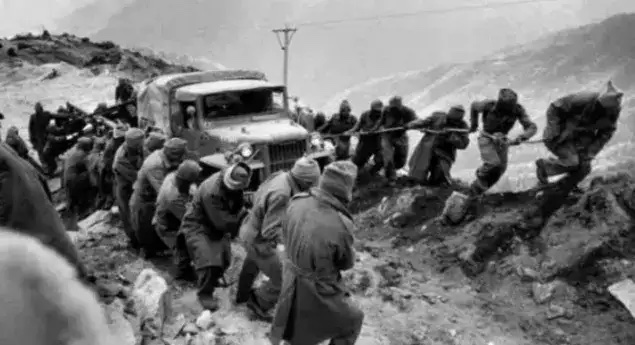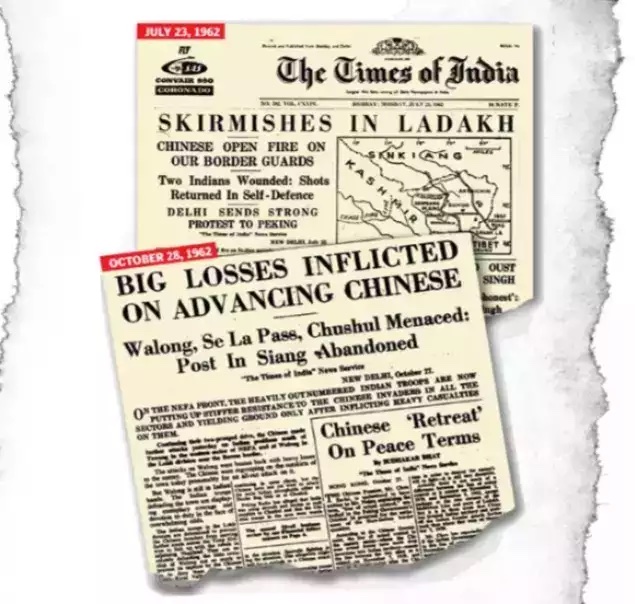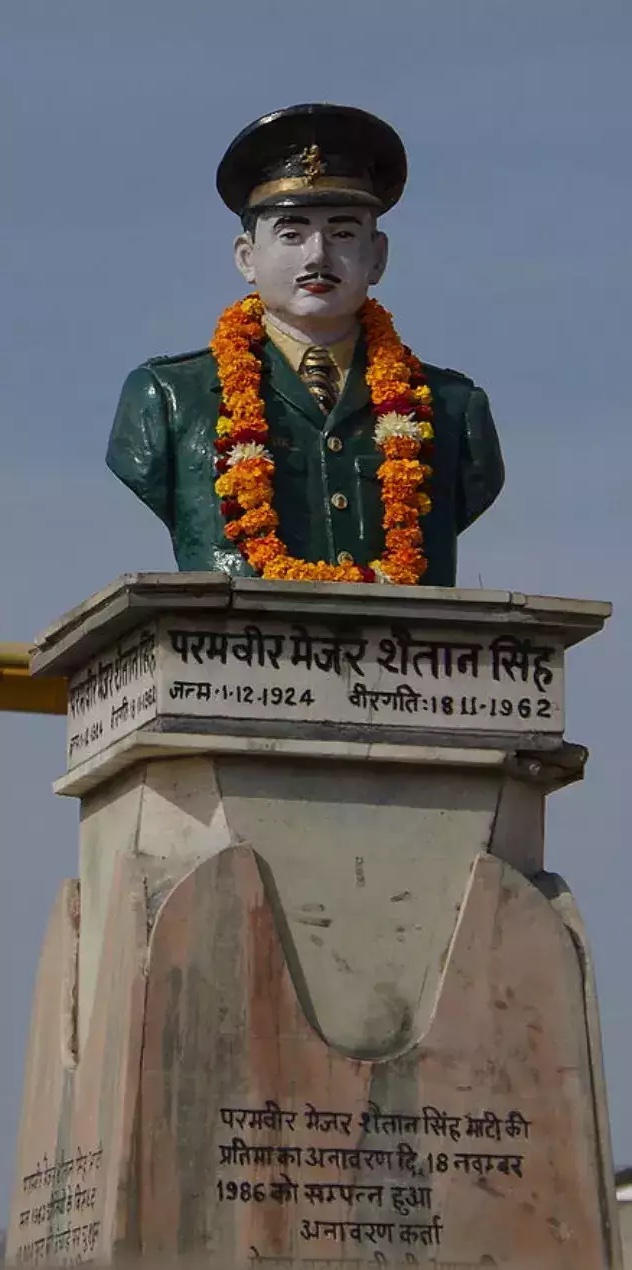1962: Rezang La
This is a collection of articles archived for the excellence of their content. |
The battle
Kulpreet Yadav’s account
Kulpreet Yadav, Oct 20, 2022: The Times of India

From: Kulpreet Yadav, Oct 20, 2022: The Times of India

From: Kulpreet Yadav, Oct 20, 2022: The Times of India

From: Kulpreet Yadav, Oct 20, 2022: The Times of India
An ex-naval officer tells the story of 120 Indian soldiers who put up a valiant fight against the 5,000-strong Chinese military troops in the 1962 Indo-China war, preventing a possible occupation of the entire Ladakh region
October 2, 1962
The defence of Ladakh in early October 1962 was the responsibility of the 114 Brigade under the command of Brigadier TN Raina, headquartered in Leh. There were four battalions under his command with a total of around 4,000 men, stretched across the 400km of Sino-Indian frontier. These battalions were 14 J&K Militia, 7 J&K Militia, 5 Jat and 1/8 Gorkha Rifles. In addition, there was a platoon (MMGs) of 1 Mahar with 1/8 Gorkha Rifles.
In October 1962, the road infrastructure in Ladakh was poor as there was only one road that connected Srinagar to Leh. All other land communications were through mule tracks and therefore, the entire supply of stores to forward Indian posts was maintained through air sorties. The only all-weather airport was in Leh.
The airstrips at other locations were designated as the Advanced Landing Grounds (ALGs) that could only be operated at certain times of the day and required a high level of maintenance after every air operation. These ALGs were located in Chushul, Daulat Beg Oldi, Thoise and Fukche.
The Dropping Zones (DZ) had a different set of challenges. Since the DZs needed to be planned in flattened terrains and the forward posts had to be close to them, the border posts were often deployed in tactically disadvantaged positions. The Chinese, who were more in number and had well-connected posts with roads reaching their base establishments in the deep, often seized Indian supplies.
By now, the entire nation was convinced that India and China would go to war. Even though Prime Minister Jawaharlal Nehru had said in Parliament, as All India Radio had reported, that the few instances of attacks by the Chinese and the counter-attacks by the Indians on the border posts were localised incidents and would not lead to war, the mood of the nation was different.
In the coming days, the 120 jawans of the Charlie Company restricted themselves to just three things: Maintaining .303 Lee Enfield bolt-action rifles and other weapons, sharing stories and jokes with one another, and writing letters home.
Another topic that was common in almost all the conversations was about the latest films. Ganga Jumna, starring Dilip Kumar and Vyjayanthimala, was a favourite. But this was not the only one. Many jawans also talked about Junglee, starring Shammi Kapoor and Saira Banu, and Hum Dono that had Dev Anand in a double role, in both roles as an army officer. There were many battle sequences in Hum Dono and these scenes were a matter of much debate and discussion among the jawans.
Meanwhile, on October 10, 1962, in the eastern part of the country, an Indian Army patrol of 50 troops at Yumtso La in North-East Frontier Agency (NEFA) encountered 1,000 Chinese soldiers. This was a dangerous face-to-face confrontation and clearly one-sided. Tragically, there was no artillery support available for the Indian patrol. Both sides held their fire for some time but finally, the Chinese opened fire on the Indian troops and a gun battle ensued. The Indians fought back, inflicting heavy casualties on the Chinese. At this point, the Chinese started to fire with mortars. As the Chinese were regrouping and the Indian patrol’s commander was able to contact Brigadier John Dalvi, their brigade commander, he was ordered to retreat. This, the brigadier justified later, was the best course of action given the hopeless situation for the Indian jawans. The Chinese stopped firing as they watched the Indians retreat and in fact, they buried the Indian soldiers with full military honours in front of the retreating soldiers’ eyes. The Indians lost 25 soldiers on that day while the Chinese lost 33. Although the situation had been defused, it acted as a catalyst for both the nations to fast-track their war preparedness.
Also, in October 1962, 350 Chinese troops had surrounded the Indian post at Srijap, located on the north shore of the Pangong Tso Lake in Ladakh, and used loudspeakers to influence the 1/8 Gorkha Rifles that was deployed there that, being Gorkhas, they should not be fighting for India. After intimidating the Indians, they finally withdrew. The jawans had only two sources of information regarding what was happening. One was through Captain Prem Kumar, who was their company commander in the absence of Major Shaitan Singh, and the second was through the All India Radio news bulletins. There were rumours as well and though the jawans listened to them, they paid no attention as they were trained to ignore rumours. It was due to incidents like these that all four companies of 13 Kumaon were ordered to move in small batches from Leh towards the Chushul airstrip. There was another reason that had prompted the government to step up the defence preparations in Ladakh. Based on the decision of the Forward Policy that was taken in a meeting in the prime minister’s office during November 1961, 36 new posts had been established all along the Ladakh border by October 1962. Since these posts were small, often just section-size or platoon-size, they were often encircled by the Chinese and harassed. The Chinese did this because they thought that the Indians were trying to forcibly occupy the areas that they considered their own. Due to a diplomatic and a political stalemate with China at the top, the Indian Army, which had seen no expansion since independence from Britain in 1947 and considered a burden on the exchequer in a politically-perceived non-aligned future of the world, was gripped by tussles between senior officers in Delhi.
In October 1962, no one had any idea that the nation was just days away from paying a heavy price.
October 20, 1962
Ladakh
The war with China that the prime minister of India was convinced would never take place, however, started on October 20, 1962, as China’s People’s Liberation Army (PLA) launched a simultaneous and well-planned attack on the forward Indian posts in NEFA and Ladakh. Within four days, the PLA had captured all the Indian posts it considered as Chinese.
The Indian Army was ill-prepared for this massive attack due to various reasons. Disadvantaged by a ratio of 10:1 in terms of manpower, broadly, these reasons included outdated guns with the Indian jawans, insufficient ammunition, absence of roads, poor intelligence and even a lack of snow clothing and availability of basic stores.
For the purpose of my story, let’s restrict ourselves to the Chushul area only. During this period, the Indian forward posts located in the Chushul sector came under the Chinese attack too. Three posts, called Srijap, Srijap 1 and Srijap 2, all located in proximity to one another, were overwhelmed. The Gorkhas fought valiantly, but they were just a few dozen as compared to the Chinese who were in their hundreds.
In Srijap, Major Dhan Singh Thapa was in command of the Delta Company of 1/8 Gorkha Rifles. The Delta Company was stretched thin as it had only twenty-eight jawans present at the time. Another key problem was the fact that since the post was located on the northern shore of the Pangong Tso Lake, there was no road link with its headquarters in Chushul and all the logistics were supplied by boats. When the attack came at 04:30 hours on October 20, 1962, in the form of a heavy artillery attack, the brave Gorkhas took shelter in their well-prepared bunkers. Thereafter, under the cover of artillery attack, as the Chinese infantry troops reached as close as 150 yards from the Indians, the company opened fire using LMGs and rifles.
The first Chinese attack was defeated. Similarly, two more attacks were defeated by the Gorkhas. But by now, the brigade headquarters had lost communication with the company due to intense bombing and therefore dispatched the two storm boats belonging to the army to check the status of the Delta Company.
When the boats were halfway across the lake, they were fired upon by the Indian Chinese. While one boat sank and its crew died, the second boat was successful in coming back. The sepoy who was present in this boat confirmed the brigade’s worst fears that the Indian post had been annihilated and everyone, including Major Dhan Singh Thapa, had been martyred.
Later, however, the Indian government would realise that the company commander was alive and, in fact, had been taken prisoner by the Chinese along with two more jawans.
Similar to Srijap, on the southern edge of the Pangong Tso Lake, there were three posts collectively called the Yula complex. These were manned by another company of 1/8 Gorkha Rifles, while the other two companies of the battalion held the Spanggur Gap, Gurung Hill and Maggar Hill. After the Chinese bombarded them heavily, all these posts were initially consolidated in one location for tactical reasons and subsequently withdrawn.
The jawans of 13 Kumaon received the news of the martyrdom of the Gorkhas in trickles. This was a sad blow for them and they were stunned into silence. Unable to do anything for their fellow soldiers, all they could do was join their hands and pray.
But, as their emotions stabilised, the jawans felt more clear-headed. By now, they had been acclimatised to the altitude of Leh and therefore, after taking permission from the JCOs, the jawans started their physical exercises to sweat out their pent- up anger and frustration. Lance Naik Singh Ram, assisted by his brother, Sepoy Ram Kumar and others, organised group competitions too.
(Excerpted with permission from The Battle of Rezang La, published by Penguin Random House)
The heroes
Nov 18, 2021: The Indian Express
So painful, indeed traumatic, is the story of the 1962 border war with China that the spotlight needs to be turned on whatever little did go right amidst the overwhelming disaster when almost everything else went unbelievably wrong. Sadly, the Indian army did disgrace itself. But it was the incompetence of the army high command, consisting largely of amiable frauds or flatterers who had flourished until then, which drove the army to its nadir, not the rank and file or young officers…
The brightest of the bright spots in the pervasive darkness of 1962 was the Battle of Rezang La in the high Himalayas in Ladakh. The place is a massive 16,000-foot-high feature in the narrow gap between the even higher mountains surrounding the strategic village of Chushul and the Spanggur Lake that stretches across both Indian and Chinese territories. Rezang La is therefore, vital for the defence of the crucially important Chushul. Any invader reaching there would have had a free run to Leh.
The 13th battalion of the Kumaon Regiment was entrusted with the defence of Chushul. Its C Company, consisting of 117 men, commanded by a major with the unusual name, Shaitan Singh, was responsible for holding Rezang La. He had deployed his three platoons across a two-kilometre frontage deftly with a view to protecting Rezang La from whatever side the Chinese might choose to attack. His men were well-entrenched and reasonably well-equipped. But they did not have mines, and the overhead shelter for the command posts was inadequate in sub-zero temperature.
It was at first light on November 18 that the first Chinese attack came. Two of the three Indian platoons opened relentless rifle, machine gun and mortar fire on the advancing Chinese and repulsed them. The Chinese casualties were heavy. Their immediate reaction was intense artillery firing on Indian positions. Later, they made a second attempt to occupy Rezang La, this time with a four-to-one numerical superiority.
The Indian platoon that had previously held its fire confronted them with all the weaponry it had. After many of them had fallen, 20 of the survivors decided to charge the Indian platoon. A dozen Kumaonis jumped out of their trenches to take them on in hand-to-hand combat.
Having failed in their frontal onslaughts, the Chinese then attacked the Indian positions from the rear while keeping up the artillery and mortar barrage and eventually succeeded in overrunning the platoon shortly before China’s unilateral ceasefire.
Be it noted that these details, initially sketchy, were given to the battalion headquarters by the three grievously wounded survivors of the C Company who had managed to get there. The real glory and grandeur of the defence of Rezang La became known only three months later when, with the advent of spring, the first Indian party could climb up there.
All the 109 soldiers were frozen as they had died with weapons in hand. Five of their comrades had been taken prisoner by the Chinese. Each had fired all the ammunition he had. The C Company had literally fought to the last man and the last bullet. The Chinese casualties had been removed but there was enough evidence to show that these were many.
It was also discovered that Major Shaitan Singh, who was constantly moving from one platoon to the other, was wounded by the Chinese firing. Two of his comrades tried to carry him to safety but he told them to put him down behind a boulder and go to fight the enemy. He later died on the same spot. His body was flown to his village near Jodhpur to be cremated with full military honours. For his exemplary leadership and extraordinary courage he was awarded the Param Vir Chakra. He was the second army man to win this highest gallantry award. Several other men of the company earned the Vir Chakra, also posthumously.
As it happened, among the dead there were three members of the same family, two brothers and their brother-in-law (sister’s husband). They were the ones who had given the company early warning of the Chinese assault. A large number of men, though not related to one another, belonged to the same village.
General K S Thimayya, the most celebrated Kumaoni and independent India’s fourth army chief, applauded the defenders of Rezang La in glowing terms, as did his successor more than a decade later, General T N Raina, also belonging to the Kumaon Regiment. Wrote Thimayya: “In military history you rarely come across such examples when facing such heavy odds the men fought to the last bullet and the last man”. Indeed, in the annals of war the name of 13 Kumaon deserves to be written in letters of gold.